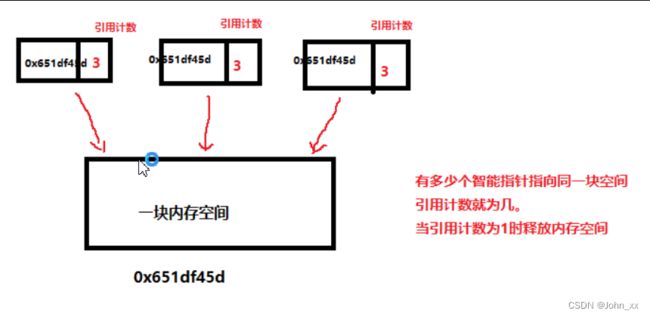- C++正则表达式语法
Coding小公仔
c/c++c++正则表达式开发语言
在C++中,正则表达式是处理文本模式匹配和字符串操作的强大工具。C++11及以后的标准库提供了头文件,支持正则表达式的使用。下面是C++正则表达式的核心语法规则和用法:一、基本正则表达式语法1.普通字符直接匹配自身,例如:a匹配字符a。2.元字符(需转义)具有特殊含义的字符,需用反斜杠\转义(在C++字符串中需用双反斜杠\\)。.:匹配除换行符外的任意字符。^:匹配字符串的开头。$:匹配字符串的结
- 【C++】简单学——类和对象(下)
CtrlZ小牛码
C++简单学c++开发语言
初始化列表前提:对象实例化,成员变量就整体定义了,那么成员变量是在哪里单体定义初始化的?构造函数处吗?概念概念:初始化列表是每个的成员定义初始化的位置位置:在构造函数底下结构::代表开始,代表分点classDate{public:////初始化列表Date(intyear,intmonth,intday):_year(year),_month(month),_day(day){}}语法一个成员变量
- 【C++】简单学——类和对象(中)
CtrlZ小牛码
C++简单学c++开发语言
六个默认成员函数共性你如果没有写这六个成员函数,编译器就会自动帮你写编译器会自动调用构造函数析构函数拷贝构造函数赋值运算符重载取地址运算符重载被const修饰的取地址运算符重载构造函数作用帮助你初始化以前的初始化的问题:总是会忘记初始化,然后用着用着就崩了使用的位置:对象实例化的时候这几个词要区分开来默认成员函数:类里“隐藏”的6个特殊函数(包括构造函数、析构函数、拷贝构造等),不写时编译器自动生
- C++程序实现阻止屏保、阻止系统自动关闭屏幕、阻止系统待机(附源码)
dvlinker
C/C++实战专栏阻止屏保阻止系统自动关闭屏幕阻止系统待机APIMonitor
目录1、概述2、设置屏幕保护程序,修改自动关闭显示器和待机的时间2.1、设置屏保程序2.2、修改自动关闭显示器和待机的时间3、通过屏保的通知消息来阻止屏保4、调用API函数SystemParametersInfo关闭/启用屏保,但存在问题4.1、初步确定处理策略4.2、启动监控进程去监控主进程4.3、系统强行关机的情况无法处理5、使用APIMonitor监测到目标程序对API的调用,找到了问题的突
- 算法竞赛备考冲刺必刷题(C++) | 洛谷 P8814 解密
热爱编程的通信人
算法c++开发语言
本文分享的必刷题目是从蓝桥云课、洛谷、AcWing等知名刷题平台精心挑选而来,并结合各平台提供的算法标签和难度等级进行了系统分类。题目涵盖了从基础到进阶的多种算法和数据结构,旨在为不同阶段的编程学习者提供一条清晰、平稳的学习提升路径。欢迎大家订阅我的专栏:算法题解:C++与Python实现!附上汇总贴:算法竞赛备考冲刺必刷题(C++)|汇总【题目来源】洛谷:P8814[CSP-J2022]解密-洛
- 【C++】atoi和std::stoi
bluebonnet27
编程语言#C++c++算法开发语言
两个将字符串转为int的方法atoi(C语言)atoi是C库中的一个函数,它定义在头文件里。其作用是把一个字符串转换为对应的整数。/*Convertastringtoaninteger.*/externintatoi(constchar*__nptr)__THROW__attribute_pure____nonnull((1))__wur;转换的原则如下:此函数接收一个以空字符'\0'结尾的字符串
- 单双链表及其反转
醇醛酸醚酮酯
开发语言
一,空指针的补充1.空指针的定义在C语言中,空指针通常被定义为NULL,或者在C++中为nullptr。它的本质是一个指针,指向无效的地址,用来表示一个指针当前没有指向有效的内存空间。空指针并不指向实际的内存地址,因此可以用于表示指针没有被初始化或者没有指向任何有效的对象。例如:int*ptr=NULL;//ptr是一个空指针在许多编译器中,空指针通常会被定义为0,或者一个特定的常量值(例如0x0
- 【C++】String的使用
nanguochenchuan
C++c++开发语言
字符串基础概念std::stringvsC风格字符串std::string是C++标准库提供的字符串类,相比C风格的char*具有明显优势:自动内存管理丰富的成员函数安全的边界检查支持运算符重载#include//必须包含的头文件std::strings1;//空字符串std::strings2="Hello";//直接初始化charcstr[]="World";std::strings3(cst
- 【Linux】ghb工具
nanguochenchuan
Linux操作系统linux运维服务器
GDB简介GDB(GNUDebugger)是Linux系统中最强大的命令行调试工具,由GNU项目开发。作为程序员调试C/C++程序的利器,GDB能帮助你:定位程序崩溃原因分析程序运行状态跟踪变量值变化检测内存错误安装与配置安装方法#Ubuntu/Debiansudoaptinstallgdb#CentOS/RHELsudoyuminstallgdb#ArchLinuxsudopacman-Sgdb
- c++ io操作(文件的读取与写入)
galaxy_strive
C++Studyc++开发语言
1文件的读取//文件操作模式//ios::app追加模式//ios::ate文件打开后定位到文件末尾//ios::in打开文件用于读取//ios::out打开文件用于写入//ios::trunc如果该文件已经存在,其内容将在打开之前被截断,即把文件长度设置为0//读取文件示例intmain(){fstreamfile("./io.txt",ios::in);//文件是否正常打开if(file.is
- c++常见英文单词(自用)
叫我六胖子
c++英文c++
c++常见英文单词application应用程式应用、应用程序applicationframework应用程式框架、应用框架应用程序框架architecture架构、系统架构体系结构argument引数(传给函式的值)。叁见parameter叁数、实质叁数、实叁、自变量array阵列数组arrowoperatorarrow(箭头)运算子箭头操作符assembly装配件assemblylanguag
- 【C++算法竞赛】前缀和+桶数组
YLCHUP
C++算法技巧算法c++开发语言数据结构哈希算法c语言笔记
文章目录1.前缀和基础2.算法原理3.例题讲解[P1114“非常男女”计划](https://www.luogu.com.cn/problem/P1114)[P11965[GESP202503七级]等价消除](https://www.luogu.com.cn/problem/P11965)[P10724[GESP202406七级]区间乘积](https://www.luogu.com.cn/pro
- 【C++】命令模式
目录一、模式核心概念与结构二、C++实现示例:遥控器与家电控制三、命令模式的关键特性四、应用场景五、命令模式与其他设计模式的关系六、C++标准库中的命令模式应用七、优缺点分析八、实战案例:数据库事务命令九、实现注意事项如果这篇文章对你有所帮助,渴望获得你的一个点赞!命令模式(CommandPattern)是一种【行为型】设计模式,它将请求封装为对象,从而使你可以用不同的请求对客户端进行参数化,对请
- C++生成静态库和动态库
什么是静态库和动态库在项目开发中,或多或少地需要使用到第三方(非编译器提供)的程序库,使用第三方的程序库能够减少重复造轮子的工作,提高开发效率。本文将介绍如何把自己的写的程序制作为程序库提供给他人使用,学会制作程序库后,自然也就会掌握了如何使用他人提供的程序库了。程序库从使用方式上分为两种,静态库和动态库。当我们在使用第三方提供的静态库时,当编译程序时,需要将我们自己写的程序和第三方库链接在一起形
- C++智能指针编程实例
lixzest
c++开发语言
智能指针是C++11引入的重要特性,用于自动管理动态分配的内存,防止内存泄漏。下面介绍几种高级智能指针编程实例。1.共享所有权模式(shared_ptr)循环引用问题及解决方案#include#includeclassB;//前向声明classA{public:std::shared_ptrb_ptr;~A(){std::couta_ptr;//这里会导致循环引用~B(){std::cout();
- C++ Lambda表达式详解:从入门到精通
Jay_515
c++Lambda
Lambda表达式是C11引入的最重要特性之一,它彻底改变了我们在C中编写函数对象的方式。本文将带你全面掌握Lambda表达式的使用技巧!1.什么是Lambda表达式?Lambda表达式是C++11引入的一种匿名函数对象,它允许我们在需要函数的地方内联定义函数,无需单独命名。Lambda的出现极大简化了代码,特别是在使用STL算法时。为什么需要Lambda?简化代码:避免为简单操作单独编写函数对象
- MongoDB框架零基础入门
码农研究僧
Python100天精通全栈mongodbnosql数据库
目录前言1.安装配置2.关启配置3.基本概念4.基本操作4.1创建集合4.2删除集合4.3插入文档4.4更新文档4.5删除文档4.6查询文档前言先科普讲解一下NoSQL(notonlysql)本身NoSQL非关系型数据库就具备了ACID(原子性、一致性、持久性、隔离性)数据持久化一般还是要使用关系型数据库,内存的数据库使用检索MongoDB是C++编写,一个基于分布式文件存储的开源数据库系统。将其
- C++学习笔记(2)——高精度减法
「已注销」
C++学习笔记(每周至少3篇)C++c++
上篇文章我们了解了高精度加法,今天我们来讲减法。和加法一样,减法也是模拟小学减法竖式:先用数组存下被减数和减数:①如果a[i]b,a[i+1]还可以向a[i+2]借位。借位后a[i+1]等于9,而b[i+1]最大为9。我们来看一下高精度减法的思路:①高精度数的读取存储:使用字符串方式读取,然后转成整型数组,为方便计算,进行逆向存储。②模拟竖式进行减法:相同位置进行相减,不够减时进行借位③去除前导0
- GPS-SDR-SIM与HackONE的融合:C++实现的高效GPS模拟
m0_57781768
c++开发语言
GPS-SDR-SIM与HackONE的融合:C++实现的高效GPS模拟前言在现代导航技术中,全球定位系统(GPS)无疑是最重要的工具之一。然而,随着技术的发展,GPS模拟器在安全测试、导航系统开发和教育等领域的应用也越来越广泛。GPS-SDR-SIM是一个开源的GPS模拟软件,通过软件定义无线电(SDR)技术,能够生成GPS信号,并用于各种GPS接收器的测试。HackONE是一种流行的SDR硬件
- Java基础:流程控制语句:条件、循环和跳转
越重天
Java基础入门教程Java宝藏java开发语言java流程控制语句零到一学Java
前言Java中的流程控制语句其实和C、C++一样,在Java中,流程控制会涉及到包括if-else、while、do-while、for、return、break以及选择语句switch。下面以此进行分析。流程控制语句,分为三大类:条件语句,循环语句和跳转语句,如下图所示:1.条件语句条件语句可根据不同的条件执行不同的语句。包括if条件语句与switch多分支语句。1.1if语句if语句
- C++高精度除以高精度
洛谷题真多
算法c++算法
高精度除以高精度的问题,在计算机科学中是一个常见的挑战,特别是在处理非常大的数字时,这些数字超出了标准数据类型(如int或longlong)的范围。这里,我们将详细解释一种常见的方法来解决这个问题:模拟手工除法。基本思路模拟手工除法的过程,即将一个高精度数(被除数)除以另一个高精度数(除数),并逐位计算商和余数。步骤详解初始化:设定被除数A和除数B(均为高精度数
- C++ 数据类型
風清掦
C++c++经验分享
使用编程语言进行编程时,需要用到各种变量来存储各种信息。变量保留的是它所存储的值的内存位置。这意味着,当创建一个变量时,就会在内存中保留一些空间。可能需要存储各种数据类型(比如字符型、宽字符型、整型、浮点型、双浮点型、布尔型等)的信息,操作系统会根据变量的数据类型,来分配内存和决定在保留内存中存储什么。基本的内置类型C++提供了种类丰富的内置数据类型和用户自定义的数据类型。下表列出了七种基本的C+
- 【基数排序介绍】
wdwc2
算法设计算法数据结构排序算法
文章目录前言一、基数排序是什么?二、基数排序的步骤(LSD低位优先)1.找出最大数的位数2.对每一位进行排序(从最低位到最高位)三、C++实现1.主函数:基数排序实现四、时间复杂度分析五、基数排序的适用场景六、与其他排序算法对比七、扩展:处理负数的思路总结前言在处理大规模整数排序问题时,比较类排序(如快速排序)可能无法发挥最优性能。本篇博客将详细介绍一种非比较类排序算法:基数排序(RadixSor
- C语言到C++快速入门
前言:通过前面的学习,我们了解了C语言的一些性质和用法,为了更加深入的学习C,我们可以向C++进阶,探究C++的知识世界,相信可以收获不少知识!一.C语言和C++的关系:起源与发展:C语言是由DennisRitchie在1970年代初期开发的,它最初是为了重新设计UNIX操作系统而创建的。C++则是在C语言的基础上发展而来的,由BjarneStroustrup在1980年代初期开始设计,其目标是增
- C# 与vb.net 的Dictionary(字典)的键、值排序
chinaherolts2008
c#开发语言vb.net教程
vb.net教程https://www.xin3721.com/eschool/vbnetxin3721/原文地址VB和VB.NET的大致区别_copico的博客-CSDN博客_vbnet和vb的语法区别VisualBasic.NET是MicrosoftVisualStudio.NET套件中主要组成部分之一。.NET版本的VisualBasic增加了更多特性,而且演化为完全面向对象(就像C++)的
- Android.mk
盼雨落,等风起
安卓脚本文件android
一、基础认知定位AndroidNDK构建系统的GNUMakefile片段,描述NDK项目结构可编译生成:APK、JAVA库、C/C++可执行程序、静态库(.a)、动态库(.so)兼容性:新源码逐渐转向Android.bp,但Android.mk仍被支持文件结构LOCAL_PATH:=$(callmy-dir)#必选:定义当前路径include$(CLEAR_VARS)#必选:清除变量(除LOCAL
- C++day02(基本数据类型)
有点。
#C++少儿c++
学习目标初始C++基本数据类型整数与加减乘除学习变量与赋值语句老师要求你每天做题之后记录做题总共用了多少秒。但是计时器只能显示分钟+秒的格式。你有办法编写程序进行时间换算吗?想知道计算机如何表示数值吗?计算机又能进行哪些计算呢?玩过身份推理桌游吗?这类桌游中的角色有不同的身份。比如狼人杀中有狼人、平民、预言家、女巫等等不同身份的身份卡。编程语言的数据也有不同的类型,比如整数类型、字符类型、浮点数类
- C语言实现 c++ 的私有属性
盼雨落,等风起
c语言c语言c++java
私有属性实现一、使用不透明结构体(OpaqueStruct)核心思路:隐藏结构体定义,仅通过接口函数操作数据。步骤:头文件(.h):声明结构体但不定义成员,仅提供函数接口://mylib.htypedefstructMyStructMyStruct;//不完整类型声明MyStruct*create_struct(intvalue);//构造函数intget_value(MyStruct*obj);
- Excel处理控件Aspose.Cells教程:Java 在 Excel 中插入和删除行和列
Aspose.Cells是Excel电子表格编程API,可加快电子表格的管理和处理任务,支持构建能够生成,修改,转换,呈现和打印电子表格的跨平台应用程序。同时不依赖于MicrosoftExcel或任何MicrosoftOfficeInterop组件,AsposeAPI支持旗下产品覆盖文档、图表、PDF、条码、OCR、CAD、HTML、电子邮件等各个文档管理领域,为全球.NET、Java、C++等1
- 【C#】实现C#传回调函数到C++,由C++计算结果回调返回
加号3
c#c++
1.C++代码实现.h代码extern"C"typedefint(*Callback)(int);extern"C"__declspec(dllexport)voidRegisterCallback(Callbackcb,intx,inty);.cpp代码#include"CallBack.h"voidRegisterCallback(Callbackcb,intx,inty){intresult
- LeetCode[位运算] - #137 Single Number II
Cwind
javaAlgorithmLeetCode题解位运算
原题链接:#137 Single Number II
要求:
给定一个整型数组,其中除了一个元素之外,每个元素都出现三次。找出这个元素
注意:算法的时间复杂度应为O(n),最好不使用额外的内存空间
难度:中等
分析:
与#136类似,都是考察位运算。不过出现两次的可以使用异或运算的特性 n XOR n = 0, n XOR 0 = n,即某一
- 《JavaScript语言精粹》笔记
aijuans
JavaScript
0、JavaScript的简单数据类型包括数字、字符创、布尔值(true/false)、null和undefined值,其它值都是对象。
1、JavaScript只有一个数字类型,它在内部被表示为64位的浮点数。没有分离出整数,所以1和1.0的值相同。
2、NaN是一个数值,表示一个不能产生正常结果的运算结果。NaN不等于任何值,包括它本身。可以用函数isNaN(number)检测NaN,但是
- 你应该更新的Java知识之常用程序库
Kai_Ge
java
在很多人眼中,Java 已经是一门垂垂老矣的语言,但并不妨碍 Java 世界依然在前进。如果你曾离开 Java,云游于其它世界,或是每日只在遗留代码中挣扎,或许是时候抬起头,看看老 Java 中的新东西。
Guava
Guava[gwɑ:və],一句话,只要你做Java项目,就应该用Guava(Github)。
guava 是 Google 出品的一套 Java 核心库,在我看来,它甚至应该
- HttpClient
120153216
httpclient
/**
* 可以传对象的请求转发,对象已流形式放入HTTP中
*/
public static Object doPost(Map<String,Object> parmMap,String url)
{
Object object = null;
HttpClient hc = new HttpClient();
String fullURL
- Django model字段类型清单
2002wmj
django
Django 通过 models 实现数据库的创建、修改、删除等操作,本文为模型中一般常用的类型的清单,便于查询和使用: AutoField:一个自动递增的整型字段,添加记录时它会自动增长。你通常不需要直接使用这个字段;如果你不指定主键的话,系统会自动添加一个主键字段到你的model。(参阅自动主键字段) BooleanField:布尔字段,管理工具里会自动将其描述为checkbox。 Cha
- 在SQLSERVER中查找消耗CPU最多的SQL
357029540
SQL Server
返回消耗CPU数目最多的10条语句
SELECT TOP 10
total_worker_time/execution_count AS avg_cpu_cost, plan_handle,
execution_count,
(SELECT SUBSTRING(text, statement_start_of
- Myeclipse项目无法部署,Undefined exploded archive location
7454103
eclipseMyEclipse
做个备忘!
错误信息为:
Undefined exploded archive location
原因:
在工程转移过程中,导致工程的配置文件出错;
解决方法:
- GMT时间格式转换
adminjun
GMT时间转换
普通的时间转换问题我这里就不再罗嗦了,我想大家应该都会那种低级的转换问题吧,现在我向大家总结一下如何转换GMT时间格式,这种格式的转换方法网上还不是很多,所以有必要总结一下,也算给有需要的朋友一个小小的帮助啦。
1、可以使用
SimpleDateFormat SimpleDateFormat
EEE-三位星期
d-天
MMM-月
yyyy-四位年
- Oracle数据库新装连接串问题
aijuans
oracle数据库
割接新装了数据库,客户端登陆无问题,apache/cgi-bin程序有问题,sqlnet.log日志如下:
Fatal NI connect error 12170.
VERSION INFORMATION: TNS for Linux: Version 10.2.0.4.0 - Product
- 回顾java数组复制
ayaoxinchao
java数组
在写这篇文章之前,也看了一些别人写的,基本上都是大同小异。文章是对java数组复制基础知识的回顾,算是作为学习笔记,供以后自己翻阅。首先,简单想一下这个问题:为什么要复制数组?我的个人理解:在我们在利用一个数组时,在每一次使用,我们都希望它的值是初始值。这时我们就要对数组进行复制,以达到原始数组值的安全性。java数组复制大致分为3种方式:①for循环方式 ②clone方式 ③arrayCopy方
- java web会话监听并使用spring注入
bewithme
Java Web
在java web应用中,当你想在建立会话或移除会话时,让系统做某些事情,比如说,统计在线用户,每当有用户登录时,或退出时,那么可以用下面这个监听器来监听。
import java.util.ArrayList;
import java.ut
- NoSQL数据库之Redis数据库管理(Redis的常用命令及高级应用)
bijian1013
redis数据库NoSQL
一 .Redis常用命令
Redis提供了丰富的命令对数据库和各种数据库类型进行操作,这些命令可以在Linux终端使用。
a.键值相关命令
b.服务器相关命令
1.键值相关命令
&
- java枚举序列化问题
bingyingao
java枚举序列化
对象在网络中传输离不开序列化和反序列化。而如果序列化的对象中有枚举值就要特别注意一些发布兼容问题:
1.加一个枚举值
新机器代码读分布式缓存中老对象,没有问题,不会抛异常。
老机器代码读分布式缓存中新对像,反序列化会中断,所以在所有机器发布完成之前要避免出现新对象,或者提前让老机器拥有新增枚举的jar。
2.删一个枚举值
新机器代码读分布式缓存中老对象,反序列
- 【Spark七十八】Spark Kyro序列化
bit1129
spark
当使用SparkContext的saveAsObjectFile方法将对象序列化到文件,以及通过objectFile方法将对象从文件反序列出来的时候,Spark默认使用Java的序列化以及反序列化机制,通常情况下,这种序列化机制是很低效的,Spark支持使用Kyro作为对象的序列化和反序列化机制,序列化的速度比java更快,但是使用Kyro时要注意,Kyro目前还是有些bug。
Spark
- Hybridizing OO and Functional Design
bookjovi
erlanghaskell
推荐博文:
Tell Above, and Ask Below - Hybridizing OO and Functional Design
文章中把OO和FP讲的深入透彻,里面把smalltalk和haskell作为典型的两种编程范式代表语言,此点本人极为同意,smalltalk可以说是最能体现OO设计的面向对象语言,smalltalk的作者Alan kay也是OO的最早先驱,
- Java-Collections Framework学习与总结-HashMap
BrokenDreams
Collections
开发中常常会用到这样一种数据结构,根据一个关键字,找到所需的信息。这个过程有点像查字典,拿到一个key,去字典表中查找对应的value。Java1.0版本提供了这样的类java.util.Dictionary(抽象类),基本上支持字典表的操作。后来引入了Map接口,更好的描述的这种数据结构。
&nb
- 读《研磨设计模式》-代码笔记-职责链模式-Chain Of Responsibility
bylijinnan
java设计模式
声明: 本文只为方便我个人查阅和理解,详细的分析以及源代码请移步 原作者的博客http://chjavach.iteye.com/
/**
* 业务逻辑:项目经理只能处理500以下的费用申请,部门经理是1000,总经理不设限。简单起见,只同意“Tom”的申请
* bylijinnan
*/
abstract class Handler {
/*
- Android中启动外部程序
cherishLC
android
1、启动外部程序
引用自:
http://blog.csdn.net/linxcool/article/details/7692374
//方法一
Intent intent=new Intent();
//包名 包名+类名(全路径)
intent.setClassName("com.linxcool", "com.linxcool.PlaneActi
- summary_keep_rate
coollyj
SUM
BEGIN
/*DECLARE minDate varchar(20) ;
DECLARE maxDate varchar(20) ;*/
DECLARE stkDate varchar(20) ;
DECLARE done int default -1;
/* 游标中 注册服务器地址 */
DE
- hadoop hdfs 添加数据目录出错
daizj
hadoophdfs扩容
由于原来配置的hadoop data目录快要用满了,故准备修改配置文件增加数据目录,以便扩容,但由于疏忽,把core-site.xml, hdfs-site.xml配置文件dfs.datanode.data.dir 配置项增加了配置目录,但未创建实际目录,重启datanode服务时,报如下错误:
2014-11-18 08:51:39,128 WARN org.apache.hadoop.h
- grep 目录级联查找
dongwei_6688
grep
在Mac或者Linux下使用grep进行文件内容查找时,如果给定的目标搜索路径是当前目录,那么它默认只搜索当前目录下的文件,而不会搜索其下面子目录中的文件内容,如果想级联搜索下级目录,需要使用一个“-r”参数:
grep -n -r "GET" .
上面的命令将会找出当前目录“.”及当前目录中所有下级目录
- yii 修改模块使用的布局文件
dcj3sjt126com
yiilayouts
方法一:yii模块默认使用系统当前的主题布局文件,如果在主配置文件中配置了主题比如: 'theme'=>'mythm', 那么yii的模块就使用 protected/themes/mythm/views/layouts 下的布局文件; 如果未配置主题,那么 yii的模块就使用 protected/views/layouts 下的布局文件, 总之默认不是使用自身目录 pr
- 设计模式之单例模式
come_for_dream
设计模式单例模式懒汉式饿汉式双重检验锁失败无序写入
今天该来的面试还没来,这个店估计不会来电话了,安静下来写写博客也不错,没事翻了翻小易哥的博客甚至与大牛们之间的差距,基础知识不扎实建起来的楼再高也只能是危楼罢了,陈下心回归基础把以前学过的东西总结一下。
*********************************
- 8、数组
豆豆咖啡
二维数组数组一维数组
一、概念
数组是同一种类型数据的集合。其实数组就是一个容器。
二、好处
可以自动给数组中的元素从0开始编号,方便操作这些元素
三、格式
//一维数组
1,元素类型[] 变量名 = new 元素类型[元素的个数]
int[] arr =
- Decode Ways
hcx2013
decode
A message containing letters from A-Z is being encoded to numbers using the following mapping:
'A' -> 1
'B' -> 2
...
'Z' -> 26
Given an encoded message containing digits, det
- Spring4.1新特性——异步调度和事件机制的异常处理
jinnianshilongnian
spring 4.1
目录
Spring4.1新特性——综述
Spring4.1新特性——Spring核心部分及其他
Spring4.1新特性——Spring缓存框架增强
Spring4.1新特性——异步调用和事件机制的异常处理
Spring4.1新特性——数据库集成测试脚本初始化
Spring4.1新特性——Spring MVC增强
Spring4.1新特性——页面自动化测试框架Spring MVC T
- squid3(高命中率)缓存服务器配置
liyonghui160com
系统:centos 5.x
需要的软件:squid-3.0.STABLE25.tar.gz
1.下载squid
wget http://www.squid-cache.org/Versions/v3/3.0/squid-3.0.STABLE25.tar.gz
tar zxf squid-3.0.STABLE25.tar.gz &&
- 避免Java应用中NullPointerException的技巧和最佳实践
pda158
java
1) 从已知的String对象中调用equals()和equalsIgnoreCase()方法,而非未知对象。 总是从已知的非空String对象中调用equals()方法。因为equals()方法是对称的,调用a.equals(b)和调用b.equals(a)是完全相同的,这也是为什么程序员对于对象a和b这么不上心。如果调用者是空指针,这种调用可能导致一个空指针异常
Object unk
- 如何在Swift语言中创建http请求
shoothao
httpswift
概述:本文通过实例从同步和异步两种方式上回答了”如何在Swift语言中创建http请求“的问题。
如果你对Objective-C比较了解的话,对于如何创建http请求你一定驾轻就熟了,而新语言Swift与其相比只有语法上的区别。但是,对才接触到这个崭新平台的初学者来说,他们仍然想知道“如何在Swift语言中创建http请求?”。
在这里,我将作出一些建议来回答上述问题。常见的
- Spring事务的传播方式
uule
spring事务
传播方式:
新建事务
required
required_new - 挂起当前
非事务方式运行
supports
&nbs

